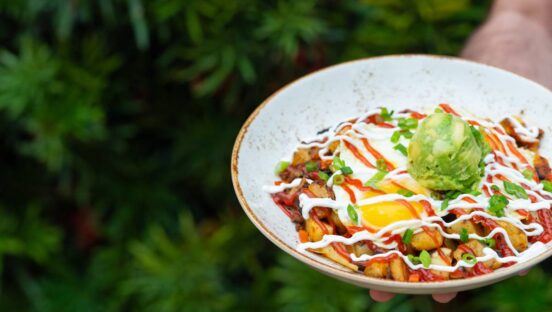





COVID-19 changed the way people interact with their world, seemingly overnight. Earlier this year, bars and restaurants were full of patrons, and less than a foot of space between individuals was more than enough to get by. Now, the theme of interaction is distance—the more the better. But how have everyday interactions and tasks adapted during this time?
For those able to work at home, rooms are doubling or tripling up as home/office/gyms. Needless to say, a safe change of pace and scenery usually comes in the form of meal deliveries from restaurants. These small moments provide a welcome break to monotony and relieve the stress of having to add more hours of work to the day, especially for families with little ones who are learning remotely.
But food delivery has changed beyond just offering customers a brief respite. Customer behavior has changed across the board, including their food ordering habits.
So, what do restaurants need to know to make sure they can meet customers’ needs? Here are some top menu trends and how to capitalize on them.
During normal times, it’s a given restaurants should be fully staffed for the weekends. However, it may be surprising to learn that weekends are still the busiest time for delivery orders even with many people staying home all week, too.
Throughout 2020, there have been twice as many sales that occur on Friday and Saturday evenings than on any other day of the week. Restaurants should prepare by ordering, receiving, and prepping inventory for dinner service on these days ahead of time.
Restaurant managers may also choose to be more strategic about when to offer promos and discounts—they aren’t needed if the restaurant is already at max delivery capacity on weekend nights. In this case, they’d be better served trying to increase demand throughout the rest of the week.
And if a restaurant isn’t seeing this influx of orders on Friday and Saturday nights? Try the opposite to grab a piece of the pie from competitors: create a weekend-only incentive or promo code, post on social media, and send a heads up to typical weekday delivery with a palm card in their bags. This will help keep the restaurant’s menu and offerings top of mind later in the week.
The work day has grown longer during quarantine as remote workers wake up, eat, and sleep in the “office.” It’s become a challenge for many to take care of routine tasks without the spatial breaks created by travelling to and from distinct workspaces. In other words, a lot of people are working through lunch right now.
This has driven a huge increase in weekday lunch delivery orders as remote workers opt for convenience instead of trying to whip up a meal between meetings. In fact, weekday lunch sales have been 1.5 times higher than dinners so far this year.
Restaurateurs won’t want to miss out on their slice of weekday lunch sales—spend some time crafting menu items that can be consumed quickly and easily for these hurried remote workers. Restaurant managers may also want to consider offering a selection of guilt-free, healthy dishes along with a few more sinful options. Sandwiches, salads, pasta, and similar dishes are perfect offerings.
The same strategy from weekend dinners can apply to weekday lunches as well. If a restaurant isn’t seeing much traction during this timeframe, they should try to promote their weekday lunch menu to weekend and dinner customers via social media, email, palm cards, and time-gated promo codes.
Fun fact: there’s been a 300 percent increase in ordering a full meal for delivery between February and September this year. Delivery has replaced in-restaurant dining for many people through closures and restrictions, and that means customers are seeking a full meal experience—at home.
Meals ordered during dinner time are 5 times as likely to contain side, dessert, and drink items as meals ordered through lunch hours. So, how can restaurant managers optimize their menus to take advantage of this ordering behavior?
It’s simple: make it easy for people to add items to entrees to build a combo meal. Most delivery platforms allow restaurants to add options to each item to add extra toppings, sauces, and similar additions. Use this section to also add options for a few sides, desserts, and drinks.
The key to this is to refrain from going overboard. Don’t add 20 side dishes to every entree as it will only serve to confuse or overwhelm customers. Instead, add the best two to four side dish pairings with each entree, one to two desserts, and the top three most popular beverages.
Women are twice as likely to place a food delivery order than men across all age groups — and they tend to order for more people at a time. Additionally, multiple studies have suggested that women and men tend to have different tastes when ordering food. Restaurants should gear their menus, descriptions, and marketing efforts toward women to cash in on this ordering trend.
In practice, this can take many forms, including:
Building female-focused audiences for digital advertisements
Offer multi-person meal bundles (including kid’s meals) to make ordering easy
Ensure your menu provides options for multiple palates—lower calorie or veggie-forward entrees, meat-based entrees, and both fruit- and chocolate-based desserts
The overall takeaway is that the new dining out is, well, dining in (home). Restaurants who play to these trends will be most poised to benefit in the near term.
How can anyone resist the temptation of ordering a dozen tacos on a Friday night instead of laboring in the kitchen after a long workday? There is no resistance. Give the people what they want.
Li-ran Navon is the founder of Say2eat, a restaurant technology company that provides restaurants with software to enable Facebook Messenger ordering, customer retargeting, and commission-free delivery. Li-ran has an extensive background in technology, startups, and hospitality over the past 10-plus years, which have helped him to develop strong expertise in revenue and order generation for restaurants.










